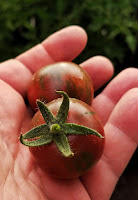Good things come in small packages. This platitude rings true for saladette tomatoes, commonly known as salad tomatoes. Their small, ping pong ball form and robust flavors deserve a special place in your garden.
Often overlooked when compared to big beefsteaks or cherry tomatoes, salad tomatoes generally grow larger than cherry tomatoes but smaller than medium-to-large paste and slicer varieties. Many varieties of salad tomatoes possess a relative tolerance to cold, so you can plant them outside when cooler temperatures prevail and other less hardy varieties must still bask in heated greenhouses. No variety of tomato, however, is frost tolerant.
Famed tomato breeder Ben Quisenberry created the Large Red Cherry, that he claims can be canned whole - seeds and all. His unique variety differs from the smaller, more commonly available tomato "Red Cherry, Large.” Lesser-known salad tomato varieties include: Garden Peach, Tigerella and Black Vernissage. As indeterminates, all three varieties require staking and pruning. Garden Peach, a "long keeper" tomato, stores well when picked green just before frost arrives in autumn. Excluding their green stems, the ripened fruit look like small, slightly fuzzy peaches. Tigerella, an English heirloom tomato, wears beautiful orange stripes over a red skin and sets fruit early, often three weeks before than other salad varieties. Immature fruits bear light and dark green stripes. Tigerella demonstrates a degree of cold tolerance and disease resistance, too. Black Vernissage tomatoes sport a deep mahogany skin with subtle green stripes. Excellent for drying, eating fresh and making tomato sauce, this variety remains productive throughout the entire season.
Another benefit of selecting a salad type tomato for your garden is resistance to the dreaded Beet Curly Top virus, a known scourge to tomato plants in the Treasure Valley. The Payette and Owyhee varieties of tomato developed in the 1960s by University of Idaho show resistance to the virus. They grow well in our region, too. Salad tomatoes have earned the right to be known as the garden workhorse. They produce prolifically and ripen fruit early compared to other non-cherry varieties, making them ideal for higher latitude and altitude gardens. During years of difficult weather conditions, they can be an insurance policy to ensure a tomato harvest. Salad tomatoes also fill multiple niches in the kitchen, performing equally well for canning, making pasta sauce, or used fresh in salsa.
Branch out, experiment, and plant new tomato varieties this season. You can’t go wrong growing salad tomatoes in your garden.
HOW



